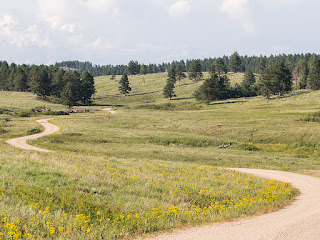The geology around the Black Hills of South Dakota contains quite a bit of limestone. Under the right conditions, groundwater dissolves away underground limestone and caverns may develop. Approximately 26,000 years ago, the roof of a cavern near present day Hot Springs, South Dakota, collapsed, creating a sinkhole. This sinkhole was about 120x150 feet at the surface and 65 feet deep, with steep walls. An artesian spring at the bottom filled the sink hole with warm water. The warm water allowed vegetation to grow at the edge of the water year round. Over the next few hundred years, an occasional animal would try to reach the vegetation or water, fall in, die and be buried, as silt washing in slowly filled the sink hole. Eventually, the sink hole was completely filled with sediment and buried skeletons, and the danger of entrapment was gone. Over the next several thousand years, the softer surrounding geology was eroded away, leaving a small hill that was the sediment that had filled the sink hole. In modern times, the community of Hot Springs, South Dakota, grew in the area.
In 1974, a landowner began earth moving operations to remove this small "hill". Luckily, the bulldozer operator stopped when he encountered what appeared to be large bones. Dr. Larry Agenbroad was brought in, started a paleontological dig, and soon realized the wealth and importance of the site. This site contains the largest collection of mammoth remains in the world. A non-profit corporation named "The Mammoth Site" was formed to own and manage the location. To date, most of the bones have been left "in situ" where they have been carefully exposed in the site. To date, 61 mammoth skeletons have been uncovered: 58 Columbian Mammoths and 3 Wooly Mammoths. It is believed that all of the mammoths have been males, most of them young males. A number of other important animal and plant fossils have also been found in the site. This location continues to be an active paleontological dig with much yet to be uncovered.
A couple of fiberglass cast replicas in the lobby/gift shop
The dig site
The tools of the trade used for uncovering fossils
The red Spearfish Sandstone formed the rim of the sinkhole, so this image shows one edge of the sinkhole.
Out tour guide mentioned that the grinding surface of mammoth molars looked like the bottoms of sneakers. Since we heard that, now when we see mammoth teeth, we always imagine some poor kid buried face down in the rocks!
Another of the animals found was the extinct Short-faced Bear. This is a cast replica in their exhibit hall.





























































